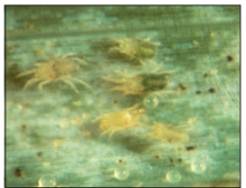Oligonychus pratensis (Banks)
The Banks grass mite is a major pest of corn throughout the western Great Plains, but is only a sporadic pest of winter wheat. Severe infestations occur when plants are under drought stress.
Identification / Life Cycle
Banks grass mites are straw to tan colored, and adults have a deep green color concentrated on either side of the posterior of the body (Figure 7.15). Adult females can be up to 1/50 inch (0.5 mm) in length, and in the fall, overwintering females are bright orange. Mite colonies produced on the leaves will contain heavy webbing that collects dust and dirt granules. Damaged leaves are folded over longitudinally with the mites inside.
Banks grass mite populations can build up through the summer in cornfields. As corn dries down in the fall, overwintering females move from corn to adjacent winter wheat or other grass hosts. They feed on the crown of these plants through the fall and winter. In the spring, mites move up on the plant to feed and establish colonies on the leaves. During periods of little rainfall in the spring, populations can build on wheat plants and cause significant damage to leaves. As wheat plants mature, mites will move to alternate hosts adjacent to the wheat (e.g., corn).
Figure 7.15 Banks grass mite.

Plant Damage / Response
Banks grass mite sucks plant juices causing leaf stippling and yellowing. Severely damaged leaves will brown, especially at the leaf tips, and plants will become brownish yellow. Mites build up to severe levels on the leaves in the spring only when very little rain occurs and wheat is under drought stress. Banks grass mites can also damage winter wheat in the fall if large populations of overwintering females feed on the crown of the plants.
Management
Establishing Risk
Wheat fields adjacent to infested corn and sorghum are at greatest risk for infestations as the overwintering females seek winter feeding sites. Severe damage is only likely to occur in combination with dry growing conditions, both in the fall and through the spring.
Chemical Control
Fall treatment of areas bordering severely infested field corn may be warranted. Treatment of spring infestations is difficult to justify because drought conditions that allow increases in mite populations will severely limit wheat yields. Rainfall will reduce mite populations and eliminate plant stress. Treatment may provide benefit if rainfall is eventually received.
